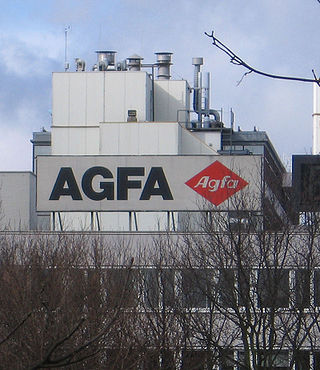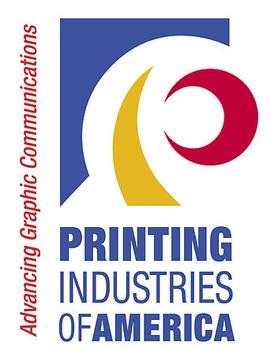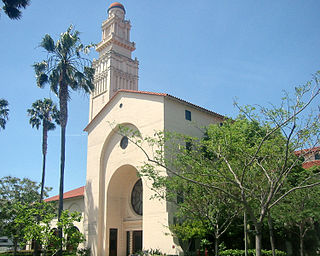
Printing is a process for mass reproducing text and images using a master form or template. The earliest non-paper products involving printing include cylinder seals and objects such as the Cyrus Cylinder and the Cylinders of Nabonidus. The earliest known form of printing as applied to paper was woodblock printing, which appeared in China before 220 AD for cloth printing. However, it would not be applied to paper until the seventh century. Later developments in printing technology include the movable type invented by Bi Sheng around 1040 AD and the printing press invented by Johannes Gutenberg in the 15th century. The technology of printing played a key role in the development of the Renaissance and the Scientific Revolution and laid the material basis for the modern knowledge-based economy and the spread of learning to the masses.

A logo is a graphic mark, emblem, or symbol used to aid and promote public identification and recognition. It may be of an abstract or figurative design or to include the text of the name that it represents as in a wordmark.

Publishing is the activity of making information, literature, music, software, and other content available to the public for sale or for free. Traditionally, the term refers to the creation and distribution of printed works, such as books, newspapers, and magazines. With the advent of digital information systems, the scope has expanded to include digital publishing such as ebooks, digital magazines, websites, social media, music, and video game publishing.

The London College of Communication is a constituent college of the University of the Arts London. Its origins are in education for the printing and retail industries; it now specialises in media-related subjects including advertising, animation, film, graphic design, photography and sound arts.

Agfa-Gevaert N.V. (Agfa) is a Belgian-German multinational corporation that develops, manufactures, and distributes analogue and digital imaging products, software, and systems.

The Pacific Community (PC), formerly the South Pacific Commission (SPC), is an international development organisation governed by 27 members, including 22 Pacific island countries and territories around the Pacific Ocean. The organisation's headquarters are in Nouméa, New Caledonia, and it has regional offices in Suva, Pohnpei, and Port Vila, as well as field staff in other locations in the Pacific. Its working languages are English and French. It primarily provides technical and scientific advice, and acts as a conduit for funding of development projects from donor nations. Unlike the slightly smaller Pacific Islands Forum, the SPC is not a trade bloc, and does not deal with military or security issues.
Prepress is the term used in the printing and publishing industries for the processes and procedures that occur between the creation of a print layout and the final printing. The prepress process includes the preparation of artwork for press, media selection, proofing, quality control checks and the production of printing plates if required. The artwork is often provided by the customer as a print-ready PDF file created in desktop publishing.

Jefferson College is a community college in Jefferson County, Missouri, in the city of Hillsboro. As of Fall 2019, Jefferson College enrollment includes 4,179 full and part-time college credit students.

The Printing Industries of America was a nonprofit trade association which advocates for the United States printing industry.

AATCC—the American Association of Textile Chemists and Colorists— is a 501(c)(6) not-for-profit professional association that provides test method development, quality control materials, educational development, and networking for textile and apparel professionals throughout the world.
Web-to-print, also known as Web2Print, remote publishing or print e-commerce is commercial printing using web sites. Companies and software solutions that deal in web-to-print use standard e-commerce and online services like hosting, website design, and cross-media marketing.
The Technical Association of the Graphic Arts (TAGA) is an organization founded in 1948 in Chicago, Illinois, United States, to publish information about the graphic arts industry. It currently operates out of Warrendale, Pennsylvania.
Gilson Graphics, Inc. is a commercial printing company in Grand Rapids, Michigan. Since its incorporation, Gilson Graphics has acquired selected assets of Knickerbocker Press, National Correct Color, Axis Digital Print and Imaging, Photolith, Commercial Printing Co., Hastings Press, and Integra Printing, Inc. Founded as Gilson Press Inc. in 1948 by Lars Gilson, the business now runs two locations in Grand Rapids and also operates a composition department in Atlantic, Iowa. Subsidiaries of the company include North Star Teacher Resources and Ignition New Media Workshop. The company is one of the largest printing companies in Grand Rapids.
Jessica Margot Weber is an American art director, graphic designer, business owner, and adjunct professor of design.
NPES, The Association for Suppliers of Printing, Publishing and Converting Technologies, is a trade association based in the United States representing more than four hundred companies that manufacture and distribute equipment, systems, software, and supplies used in printing, publishing, and converting.

The American Bus Association (ABA) is a trade association for motorcoach operators and tour companies in the United States and Canada. Its membership consists of about 1,000 companies that operate buses or bus-based tours, about 2,800 organizations representing the travel and tourism industry, and several hundred suppliers of buses and related products and services. Its headquarters is in Washington, D.C.

The Technical University of Applied Sciences Würzburg-Schweinfurt is a technical university in Germany, which was founded originally in 1807, and was restructured during 1971. The university is among the best applied sciences universities in Germany with over 150 partner universities worldwide. The university is located in Bavaria with campuses in Würzburg and Schweinfurt.

The Margaret Herrick Library, located in Beverly Hills, California, is the main repository of print, graphic and research materials of the Academy of Motion Picture Arts and Sciences (AMPAS). The library contains a digital repository and has historical materials that include those relating to the Oscars awards show.

Sadjad University is one of the most reputable universities in Mashhad, Iran. Founded in 1995 in Mashhad, it has always ranked first among the non-governmental universities of the country in the rankings released by the Ministry of Science. It is also the first university in Iran originating from an industrial research center which still functions as the university's research core.












